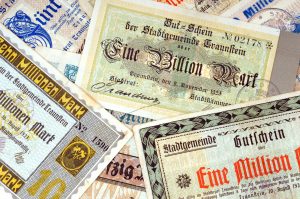Life During the Inflation of 1923
The comments above & below is an edited and abridged synopsis of an article by Charleston Voice
The most popular image of German inflation is the flood of paper money that issued from the printing presses and engulfed the nation. The struggle was hard, tragic and often ridiculous.
 The chief cause was the Reichsbank’s policy of simply printing more money to counter the country’s debt caused by WWI and the reparations owing. The German mark plummeted on the international money markets, and inflation soared.
The chief cause was the Reichsbank’s policy of simply printing more money to counter the country’s debt caused by WWI and the reparations owing. The German mark plummeted on the international money markets, and inflation soared.
Inflation peaked in 1923 at a staggering 300 million percent. When inflation was finally stopped by the introduction of the Rentenmark in November 1923, the exchange rate was 4.2 trillion marks to the US dollar (4,200,000,000,000 marks).
Prices and incomes changed daily. People who did not convert their savings into tangible assets lost them. Pensions became worthless, and most of the middle class was reduced to poverty. Many starved to death. Conditions were so harsh that around 20,000 dogs were slaughtered for human consumption in 1923 alone.
In July 1922, a law was passed to permit the printing of emergency money with certain safeguards. After that, municipal banks, the railways, local authorities and also private firms used this law to start printing their own money. More than 2,000 kinds of emergency money were circulating, and many of them were not authorized.
At some stages during the inflation, the inflation rate had jumped ahead so far that large amounts of money still sitting in the Reichsbank vaults were already worthless. For instance, in 1923 the worthless 1,000 mark note of 1922 was overprinted and re-issued at one million times its previous value: ‘eine Milliarde mark’—a billion marks.
